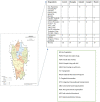Finding a way forward with the community: qualitative inquiry in the generalized HIV epidemic in Mizoram, India
- PMID: 37554736
- PMCID: PMC10405924
- DOI: 10.3389/fpubh.2023.1217628
Finding a way forward with the community: qualitative inquiry in the generalized HIV epidemic in Mizoram, India
Abstract
Introduction: Mizoram, the northeastern State of India bordering Myanmar, is presently witnessing a burgeoning generalized HIV epidemic along with the highest State-level HIV prevalence among female sex workers (FSWs, 24.7%) and people who inject drugs (PWID,19.8%) in the country. The present study was conducted against such background to understand the current situation of HIV prevention and care services in Mizoram, and capture community voices as well as concerns so that the way forward could be informed appropriately.
Methods: The study period was October through December 2020 (in the midst of COVID-restrictions) in the districts of Aizawl, Mamit, Kolasib, Lunglei, and Champhai where HIV prevalence crossed 1% among ante-natal clinic (ANC) attending women. Contrastingly, the national average HIV prevalence among ANC attendees is 0.24%, which formed the basis for selecting the aforementioned five high burden districts for this current inquiry. In-depth-interviews were conducted with community members and youth leaders, vulnerable and general population groups as well as HIV-program officials. Interviews were recorded, transcribed, translated and later coded for analysis following thematic approach.
Results: The emerging issues were grouped in three thematic layers; (1) HIV vulnerability, (2) challenges pertaining to prevention and care services, and (3) program elements and future roadmap. Discrimination at the community level, unfriendly behavior of some of the HIV-service staff, occasional interruption in supplies of anti-retroviral treatment and sterile syringes and needles were voiced as deterrents to accessing HIV prevention and care services by the participants. Community engagement, based on restorative approach rather than retribution and ensuring enhanced performance of the district AIDS program control units emerged as necessary programmatic elements.
Conclusion: This inquiry highlighted macro-social and structural forces contributing to stigma and discrimination toward people at risk of HIV. It is urgent that HIV-services are re-aligned through de-centralized district level innovations and creation of safer spaces at the physical, societal and familial level. These, even during the time of stress such as a pandemic, would help health services to remain resilient. HIV outreach, sensitization of the community leaders and health-care professionals through strategic communication and ownership of the communities in these endeavors appeared paramount.
Keywords: HIV; Mizoram; community consultations; generalized epidemic; restorative community building.
Copyright © 2023 Rao, Mamulwar, Panda, Pachuau, Vanlalvenzuali, Lalruatsanga, Roy and Lalnuntlangi.
Conflict of interest statement
The authors declare that the research was conducted in the absence of any commercial or financial relationships that could be construed as a potential conflict of interest.
Figures
References
-
- National AIDS. Control organization, Ministry of Health & Family Welfare, Government of India. Strategy document: National AIDS and STD control programme phase-V (2021-2026) – Anchoring the national response towards ending the AIDS epidemic. National AIDS Control Organization; (2022).
-
- Rao S. Do we care?: India’s health system New Delhi, India: Oxford University Press; (2017).
-
- National AIDS National AIDS Control organization operational guideline district AIDS program control unit. New Delhi India: National AIDS Control Organization, (2012). Available at: https://naco.gov.in/sites/default/files/Revised%20DAPCU%20Operational%20... (Accessed 30th June 2023).
-
- National AIDS control organization, Ministry of Health and Family Welfare, government of India. New Delhi, India: National Guidelines for HIV Care and Treatment, National AIDS Control Organization. (2021).
Publication types
MeSH terms
LinkOut - more resources
Full Text Sources
Medical





